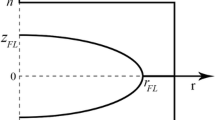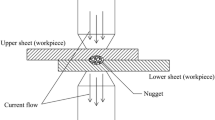Abstract
In this work, an electrical–thermal–mechanical coupled finite element (FE) model for resistance spot welding (RSW) process is developed to achieve a simultaneous simulation of not only nugget growth but also process signals including dynamic resistance and electrode displacement. The model entails a multi-objective optimization problem of hard-to-measure physical quantities. During the optimization process, the limitation of adjusting only the interface contact parameters is found and corrected by introducing an enhanced thermal conductivity due to molten metal flow. Experimental validation confirmed simulation accuracy and adaptability to sheet metal thickness and welding process parameter variation. The model can directly generate process signal data with accurate quality indexes, which supports solving the problem of insufficient labeled data in model training for RSW quality prediction.















Similar content being viewed by others
References
Qi L, Li F, Chen R et al (2020) Improve resistance spot weld quality of advanced high strength steels using bilateral external magnetic field. J Manuf Process 52:270–280. https://doi.org/10.1016/j.jmapro.2020.02.030
Ashiri R, Haque MA, Ji C-W et al (2015) Supercritical area and critical nugget diameter for liquid metal embrittlement of Zn-coated twining induced plasticity steels. Scripta Mater 109:6–10. https://doi.org/10.1016/j.scriptamat.2015.07.006
Xia Y-J, Zhou L, Shen Y et al (2021) Online measurement of weld penetration in robotic resistance spot welding using electrode displacement signals. Measurement 168(1):108397–108311. https://doi.org/10.1016/j.measurement.2020.108397
Zhou K, Yao P (2019) Overview of recent advances of process analysis and quality control in resistance spot welding. Mech Syst Signal Process 124(6):170–198. https://doi.org/10.1016/j.ymssp.2019.01.041
Zhang H, Wang F, Tao X et al (2015) A novel quality evaluation method for resistance spot welding based on the electrode displacement signal and the Chernoff faces technique. Mech Syst Signal Process 62–63:431–443
Zhao D, Wang Y, Lin Z et al (2013) An effective quality assessment method for small scale resistance spot welding based on process parameters. NDT and E Int 55(3):36–41
Xing BB, Xiao Y, Qin QH et al (2017) Quality assessment of resistance spot welding process based on dynamic resistance signal and random forest based. Int J Adv Manuf Technol 94(1–4):327–339. https://doi.org/10.1007/s00170-017-0889-6
Chen G, Sheng BY, Luo RP et al (2022) A parallel strategy for predicting the quality of welded joints in automotive bodies based on machine learning. J Manuf Syst 62(1):636–649. https://doi.org/10.1016/j.jmsy.2022.01.011
EI-Sari B, Biegler M, Rethmeier M (2021) Investigation of the extrapolation capability of an artificial neural network algorithm in combination with process signals in resistance spot welding of advanced high-strength steels. Meatals 11(11):1874–1811. https://doi.org/10.3390/met11111874
Zhou B, Pychynski T, Reischl M et al (2018) Comparison of machine learning approaches for time-series-based quality monitoring of resistance spot welding. Arch Data Sci, Ser 5(1):13–29. https://doi.org/10.5445/KSP/1000087327/13
Zhou K, Wang G, Yu W et al (2022) Analysis of process signals of resistance spot welding for dp590 steel using numerical calculation. ISIJ Int 62(9):1896–1907. https://doi.org/10.2355/isijinternational.ISIJINT-2022-100
GMW (2018) Weld acceptance criteria and repair procedures resistance spot welds – steel. In (Vol. GMW14057). USA: General Motors Corp
Xia YJ, Zhang ZD, Xia ZX et al (2016) A precision analogue integrator system for heavy current measurement in MFDC resistance spot welding. Meas Sci Technol 27(2):025104–025111. https://doi.org/10.1088/0957-0233/27/2/025104
Su ZW, Xia YJ, Shen Y et al (2020) A novel real-time measurement method for dynamic resistance signal in medium-frequency DC resistance spot welding. Meas Sci Technol 31(5):055011–055012. https://doi.org/10.1088/1361-6501/ab6673
Xia YJ, Su ZW, Lou M et al (2020) Online precision measurement of weld indentation in resistance spot welding using servo gun. IEEE Trans Instrum Meas 69(7):4465–4475. https://doi.org/10.1109/tim.2019.2943981
Xia YJ, Su ZW, Li YB et al (2019) Online quantitative evaluation of expulsion in resistance spot welding. J Manuf Process 46:34–43. https://doi.org/10.1016/j.jmapro.2019.08.004
Qi L, Zhang Q, Niu S et al (2021) Influencing mechanism of an external magnetic field on fluid flow, heat transfer and microstructure in aluminum resistance spot welding. Eng Appl Comput Fluid Mech 15(1):985–1001. https://doi.org/10.1080/19942060.2021.1938684
Wan Z-X, Wang H-P, Wang M et al (2016) Numerical simulation of resistance spot welding of al to zinc-coated steel with improved representation of contact interactions. Int J Heat Mass Transf 101(10):749–763. https://doi.org/10.1016/j.ijheatmasstransfer.2016.05.023
Wang J, Wang H-P, Lu F et al (2015) Analysis of al-steel resistance spot welding process by developing a fully coupled multi-physics simulation model. Int J Heat Mass Transf 89(10):1061–1072. https://doi.org/10.1016/j.ijheatmasstransfer.2015.05.086
Schwenk C, Rethmeier M (2011) Material properties for welding simulation - measurement, analysis, and exemplary data. Weld J 90(11):220s–227s
Eshraghi M, Tschopp MA, Asle Zaeem M et al (2014) Effect of resistance spot welding parameters on weld pool properties in a DP600 dual-phase steel: a parametric study using thermomechanically-coupled finite element analysis. Mater Des 56(4):387–397. https://doi.org/10.1016/j.matdes.2013.11.026
Hamedi M, Atashparva M (2017) A review of electrical contact resistance modeling in resistance spot welding. Weld World 61(2):269–290. https://doi.org/10.1007/s40194-016-0419-4
Song QF, Zhang WQ, Bay N (2005) An experimental study determines the electrical contact resistance in resistance welding. Weld J 84(5):73s–76s
Li YB, Lin ZQ, Shen Q et al (2011) Numerical analysis of transport phenomena in resistance spot welding process. J Manuf Sci Eng 133(3):031019–31013. https://doi.org/10.1115/1.4004319
Alcini WV (1990) Experimental measurement of liquid nugget heat convection in spot welding. Weld J 69(5):177s–180s
Kaars J, Mayr P, Koppe K (2018) Determining material data for welding simulation of presshardened steel. Metals 8(10):740–754. https://doi.org/10.3390/met8100740
Sherepenko O, Jüttner S (2018) Transient softening at the fusion boundary in resistance spot welded ultra-high strengths steel 22MnB5 and its impact on fracture processes. Weld World 63(1):151–159. https://doi.org/10.1007/s40194-018-0633-3
Li YB, Li DL, David SA et al (2016) Microstructures of magnetically assisted dual-phase steel resistance spot welds. Sci Technol Weld Joining 21(7):555–563. https://doi.org/10.1080/13621718.2016.1141493
Funding
The authors would like to acknowledge the financial support of the National Natural Science Foundation of China (Grant Nos. 52205396 and 52025058), the Postdoctoral Science Foundation of China (Grant No. 2022T150409), and the State Key Laboratory of Advanced Brazing Filler Metals and Technology (Grant No. SKLABFMT202101).
Author information
Authors and Affiliations
Corresponding author
Ethics declarations
Conflict of interest
The authors declare no competing interests.
Additional information
Publisher's note
Springer Nature remains neutral with regard to jurisdictional claims in published maps and institutional affiliations.
Recommended for publication by Commission III Resistance Welding, Solid State Welding, and Allied Joining Process.
This paper was presented at the IIW 2022 International Conference on Innovative Welding and Joining Technologies to achieve Carbon Neutrality and promote Sustainable Development held in Tokyo, Japan.
Appendices
Appendix 1
Nomenclature
D N | measured nugget diameter (mm) |
|---|---|
D E | electrode tip diameter (mm) |
D E/S | measured indentation diameter (mm) |
DN*(t) | simulated nugget diameter at moment t (mm) |
eD N | relative calculation error of nugget diameter (%) |
eP N | relative calculation error of weld penetration (%) |
eR | relative calculation error of dynamic resistance (%) |
eS | relative calculation error of electrode displacement (%) |
ECRA/B(T, P) | electrical contact resistance of A/B interface at temperature T and pressure P (Ωm2); A, B ∈ {S, E}, where S stands for sheet, E stands for electrode |
h a | convective heat transfer coefficients of air (W/(m2·℃)) |
h w | convective heat transfer coefficients of cooling water (W/(m2·℃)) |
h S | sheet thickness (mm) |
K C | factor related to the oxide layer or coating layer on the material surface |
L | Lorentz constant (WΩ/℃2) |
P | pressure (MPa) |
P N | measured nugget penetration (mm) |
PN*(t) | simulated weld penetration at moment t (mm) |
R(t) | measured dynamic resistance signal at moment t (μΩ) |
R*(t) | simulated dynamic resistance at moment t (μΩ) |
R A/B | resistance of A/B interface (μΩ); A, B ∈ {S, E, P}, where S stands for sheet, E stands for electrode, P stands for probe |
R E | bulk resistances of one electrode (μΩ) |
R S | bulk resistances of one sheet (μΩ) |
R ti | resistance measurement at condition i (μΩ); i = 1 ~ 3 |
S(t) | measured electrode displacement signal at moment t (μm) |
S*(t) | simulated electrode displacement at moment t (μm) |
T | time (ms) |
t w | heating time (ms) |
T | temperature (°C) |
T 0 | room temperature (°C) |
T m | melting point of sheet (°C) |
TCRA/B(T, P) | thermal contact resistance of A/B interface at temperature T and pressure P (℃m2/W); A, B ∈ {S, E}, where S stands for sheet, E stands for electrode |
U | displacement (m) |
α A/B | adjustable correction coefficient for electrical contact resistance at A/B interface; A, B ∈ {S, E}, where S stands for sheet, E stands for electrode |
β A/B | adjustable correction coefficient for thermal contact resistance at A/B interface; A, B ∈ {S, E}, where S stands for sheet, E stands for electrode |
λ m | thermal conductivity above the melting point |
σs-A/B(T) | yield strength of the softer of materials A and B at temperature T; A, B ∈ {S, E}, where S stands for sheet, E stands for electrode |
φ | potential (V) |
ρA(T) | the resistivity of material A at temperature T (μΩm); A ∈ {S, E}, where S stands for sheet, E stands for electrode |
Appendix 2
2.1 Control equations
-
1)
Stress equilibrium equation
$$\left\{\begin{array}{l}\frac{1}{r}\frac{\partial }{\partial r}\left(r{\sigma }_{rr}\right)-\frac{{\sigma }_{\theta \theta }}{r}+\frac{\partial {\sigma }_{zr}}{\partial z}=0\\ \frac{1}{r}\frac{\partial }{\partial r}\left(r{\sigma }_{zr}\right)+\frac{\partial {\sigma }_{zz}}{\partial z}=0\end{array}\right.$$where (r, θ, z) describes a cylindrical coordinate system. σrr, σθθ, and σzz represent radial, circumferential, and axial normal stress components, respectively. σzr is the shear stress component. The stress does not change along the circumference with the axial symmetry condition. Meanwhile, the influence of inertial force and gravity is ignored.
-
2)
Elastic–plastic constitutive equation
$$\left\{\begin{array}{l}\left\{d\varepsilon \right\}=\left\{d{\varepsilon }_{e}\right\}+\left\{d{\varepsilon }_{P}\right\}+\left\{d{\varepsilon }_{T}\right\}\\ \left\{d{\varepsilon }_{e}\right\}={\left[{D}_{e}\right]}^{-1}\left\{d\sigma \right\}+\frac{\partial {\left[{D}_{e}\right]}^{-1}}{\partial T}\left\{\sigma \right\}dT\\ \left\{d{\varepsilon }_{P}\right\}=d\lambda \left\{\frac{\partial Y}{\partial \sigma }\right\}\\ \left\{d{\varepsilon }_{T}\right\}=\left\{\alpha \right\}dT\end{array}\right.$$where {σ} and{dσ}, respectively, represent stress and stress increment tensors. {dε}, {dεe}, {dεP}, and {dεT} stand for the tensors of total strain increment, plastic strain increment, and thermal strain increment, respectively. [De] is the elastic stiffness matrix, [α] is the linear expansion coefficient matrix, and T stands for temperature. In addition, Y is the subsequent yield function of the material and obeys Von Mises yield criterion. dλ is a parameter related to the hardening rule and obeys the isotropic strengthening criterion.
-
3)
Current continuity equation
$$\left\{\begin{array}{l}j=-\frac{1}{\rho }\nabla \varphi \\ \nabla \cdot j=\frac{1}{r}\frac{\partial }{\partial r}\left(\frac{r}{\rho }\frac{\partial \varphi }{\partial r}\right)+\frac{\partial }{\partial z}\left(\frac{1}{\rho }\frac{\partial \varphi }{\partial z}\right)=0\end{array}\right.$$where (r, θ, z) describes a cylindrical coordinate system. j stands for current density, φ is potential, and ρ is the temperature-dependent resistivity of the material. The above equation is obtained from the current continuity equation for the constant electric field. In MFDC RSW process with constant current mode, the magnitude and frequency of current variation are low. Thus, the electric field within each time step can be approximated as quasi-static.
-
4)
Heat conduction equation
$$\left\{\begin{array}{l}\frac{\partial {H}_{v}}{\partial t}=\frac{1}{r}\frac{\partial }{\partial r}\left(\lambda r\frac{\partial T}{\partial r}\right)+\frac{\partial }{\partial z}\left(\lambda \frac{\partial T}{\partial z}\right)+{q}_{v}\\ {q}_{v}=\rho {j}^{2}=\frac{1}{\rho }{\left(\nabla \varphi \right)}^{2}=\frac{1}{\rho }\left[{\left(\frac{\partial \varphi }{\partial r}\right)}^{2}+{\left(\frac{\partial \varphi }{\partial z}\right)}^{2}\right]\end{array}\right.$$where (r, θ, z) describes a cylindrical coordinate system. T stands for temperature, φ is potential, t refers to time, Hv represents the volume enthalpy of the material, and λ is the thermal conductivity of the material. The internal heat source qv represents the power of joule heat generated by the welding current passing through the unit volume of material.
Rights and permissions
Springer Nature or its licensor (e.g. a society or other partner) holds exclusive rights to this article under a publishing agreement with the author(s) or other rightsholder(s); author self-archiving of the accepted manuscript version of this article is solely governed by the terms of such publishing agreement and applicable law.
About this article
Cite this article
Xia, YJ., Lv, TL., Ghassemi-Armaki, H. et al. Collaborative Simulation of Nugget Growth and Process Signals for Resistance Spot Welding. Weld World 67, 1377–1392 (2023). https://doi.org/10.1007/s40194-023-01489-4
Received:
Accepted:
Published:
Issue Date:
DOI: https://doi.org/10.1007/s40194-023-01489-4




